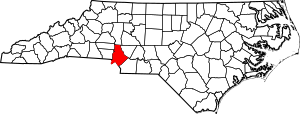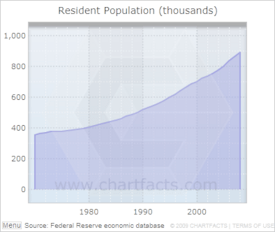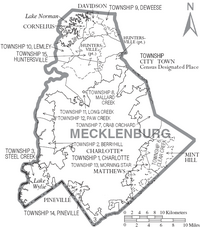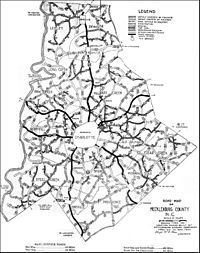Mecklenburg County, North Carolina facts for kids
Quick facts for kids
Mecklenburg County
|
|||
|---|---|---|---|
 |
|||
|
|||

Location within the U.S. state of North Carolina
|
|||
 North Carolina's location within the U.S. |
|||
| Country | |||
| State | |||
| Founded | November 6, 1762 | ||
| Named for | Charlotte of Mecklenburg-Strelitz | ||
| Seat | Charlotte | ||
| Largest city | Charlotte | ||
| Area | |||
| • Total | 546 sq mi (1,410 km2) | ||
| • Land | 524 sq mi (1,360 km2) | ||
| • Water | 22 sq mi (60 km2) 4.0%% | ||
| Population | |||
| • Estimate
(2021)
|
1,122,276 | ||
| • Density | 2,141.7/sq mi (826.9/km2) | ||
| Demonym(s) | Mecklenburger | ||
| Time zone | UTC−5 (Eastern) | ||
| • Summer (DST) | UTC−4 (EDT) | ||
| Congressional districts | 12th, 14th | ||
Mecklenburg County is a county located in the southwestern region of the state of North Carolina, in the United States. As of the 2020 census, the population was 1,115,482. Making it the second-most populous county in North Carolina (after Wake County) and the first county in the Carolinas to surpass one million in population. Its county seat is Charlotte, and is the state's largest city.
Mecklenburg County is the central county of the Charlotte-Concord-Gastonia, NC-SC Metropolitan Statistical Area. On September 12, 2013, the county welcomed its one millionth resident.
Like its seat, the county is named after Charlotte of Mecklenburg-Strelitz, Queen of the United Kingdom, whose name is derived from the region of Mecklenburg in Germany, itself deriving its name from Mecklenburg Castle (Mecklenburg meaning "large castle" in Low German) in the village of Dorf Mecklenburg.
Contents
History
Mecklenburg County was formed in 1762 from the western part of Anson County, both in the Piedmont section of the state. It was named in commemoration of the marriage of King George III to Charlotte of Mecklenburg-Strelitz, for whom the county seat Charlotte is named. Due to unsure boundaries, a large part of south and western Mecklenburg County extended into areas that would later form part of the state of South Carolina. In 1768, most of this area (the part of Mecklenburg County west of the Catawba River) was designated Tryon County, North Carolina.
Determining the final boundaries of these "western" areas between North and South Carolina was a decades-long process. As population increased in the area following the American Revolutionary War, in 1792 the northeastern part of Mecklenburg County was taken by the North Carolina legislature for Cabarrus County. Finally, in 1842 the southeastern part of Mecklenburg County was combined with the western part of Anson County to become Union County.
The Mecklenburg Declaration of Independence was allegedly signed on May 20, 1775; if the document is genuine, Mecklenburg County was the first part of the Thirteen Colonies to declare independence from Great Britain. The "Mecklenburg Resolves" were adopted on May 31, 1775. Mecklenburg continues to celebrate the Meck Dec each year in May. The Date of the Meck Dec is also listed on the Flag of North Carolina, represented by the date of May 20, 1775 as one of two dates on the flag of the old North State.
In 1971, Mecklenburg County was the site of an important case in the American civil rights movement. Swann v. Charlotte-Mecklenburg Board of Education (CMS) was a suit filed to force the integration of the public schools in Charlotte.
In 1999, the Federal Courts effectively over-ruled the Swann decision and declared that the Charlotte-Mecklenburg Board of Education was 'Unitary' and were then prohibited by then US Federal Judge Robert Potter from using race to assign students to schools. In a case initially brought by William Capacchione, on behalf of his minor daughter, CMS was sued for not allowing his daughter into a nearby (or neighborhood) school.
Geography
According to the U.S. Census Bureau, the county has a total area of 546 square miles (1,410 km2), of which 524 square miles (1,360 km2) is land and 22 square miles (57 km2) (4.0%) is water.
Adjacent counties
- Iredell County - north
- Cabarrus County - northeast
- Union County - southeast
- Lancaster County, South Carolina - south
- York County, South Carolina - southwest
- Gaston County - west
- Catawba County - northwest
- Lincoln County - northwest
Demographics
| Historical population | |||
|---|---|---|---|
| Census | Pop. | %± | |
| 1790 | 11,395 | — | |
| 1800 | 10,439 | −8.4% | |
| 1810 | 14,272 | 36.7% | |
| 1820 | 16,895 | 18.4% | |
| 1830 | 20,073 | 18.8% | |
| 1840 | 18,273 | −9.0% | |
| 1850 | 13,914 | −23.9% | |
| 1860 | 17,374 | 24.9% | |
| 1870 | 24,299 | 39.9% | |
| 1880 | 34,175 | 40.6% | |
| 1890 | 42,673 | 24.9% | |
| 1900 | 55,268 | 29.5% | |
| 1910 | 67,031 | 21.3% | |
| 1920 | 80,695 | 20.4% | |
| 1930 | 127,971 | 58.6% | |
| 1940 | 151,826 | 18.6% | |
| 1950 | 197,052 | 29.8% | |
| 1960 | 272,111 | 38.1% | |
| 1970 | 354,656 | 30.3% | |
| 1980 | 404,270 | 14.0% | |
| 1990 | 511,433 | 26.5% | |
| 2000 | 695,454 | 36.0% | |
| 2010 | 919,628 | 32.2% | |
| 2020 | 1,115,482 | 21.3% | |
| 2021 (est.) | 1,122,276 | 22.0% | |
2020 census
| Race | Number | Percentage |
|---|---|---|
| White (non-Hispanic) | 498,683 | 44.71% |
| Black or African American (non-Hispanic) | 324,832 | 29.12% |
| Native American | 2,730 | 0.24% |
| Asian | 71,583 | 6.42% |
| Pacific Islander | 531 | 0.05% |
| Other/Mixed | 47,201 | 4.23% |
| Hispanic or Latino | 169,922 | 15.23% |
As of the 2020 United States census, there were 1,115,482 people, 426,313 households, and 254,759 families residing in the county.
Mecklenburg County Government
Mecklenburg County is a member of the regional Centralina Council of Governments.
The County is governed by the Mecklenburg Board of County Commissioners (BOCC). The BOCC is a nine-member board made up of representatives from each of the six county districts and three at-large representatives elected by the entire county. This electoral structure favors candidates in the at-large positions who will be elected by the majority population of the county. Each District has a population of approximately 165,000 individuals. All seats are partisan and are for 2-year terms (elections occur in even years). The current chairman of the Mecklenburg BOCC is Ella B. Scarborough (D, At-large). The Current Vice-Chair is Jim Puckett(R, District 1).
Members of the Mecklenburg County Commission are required by North Carolina State law to choose a Chair and Vice-Chair once a year (at the first meeting of December). Historically, the individual elected was the 'top-vote-getter' which was one of thee (3) at-large members. In 2014 this unofficial rule was changed by the Board to allow any member to serve as Chair or Vice-chair as long as they received support from 4 members plus their own vote.
The nine (9) members of the Board of County Commissioners are:
- Ella Scarborough (D, At-Large - Chairman)
- Trevor Fuller (D, At-Large)
- Pat Cotham (D, At-Large)
- Jim Puckett (R, District 1, Vice Chairman)
- Vilma Leake (D, District 2)
- George Dunlap (D, District 3)
- Dumont Clarke (D, District 4)
- Matthew Ridenhour (R, District 5)
- Bill James (R, District 6)
Charlotte-Mecklenburg Schools (CMS)
The current Chairman of the Charlotte-Mecklenburg School board is Mary T. McCray (At-Large). The Vice Chair is Ericka Ellis-Stewart (At-Large). The members of the Board of Education are:
- Mary T. McCray (At-Large - Chairman)
- Elyse C. Dashew (At-Large - Vice Chair)
- Ericka Ellis-Stewart (At-Large)
- Rhonda Lennon (District 1)
- Thelma Byers-Bailey (District 2)
- Ruby M. Jones(District 3)
- Tom Tate (District 4)
- Eric C. Davis (District 5)
- Paul Bailey (District 6)
The Charlotte-Mecklenburg School board is non-partisan, and staggered elections are held every two years (in odd years).
MEDIC
The residents of Mecklenburg County are provided emergency medical service by MEDICMEDIC, the Mecklenburg EMS Agency. All emergency ambulance service is provided by MEDIC. No other emergency transport companies are allowed to operate within Mecklenburg County. While MEDIC is a division of Mecklenburg County Government, a board guides and directs MEDIC that consists of members affiliated with Carolinas Medical Center (CMC), Novant Presbyterian Hospital and a swing vote provided by the Mecklenburg County Board of Commissioners. CMC and Novant are the two major medical institutions in Charlotte, North Carolina.
Transportation
Air
The county's primary commercial aviation airport is Charlotte Douglas International Airport in Charlotte.
Intercity rail
With twenty-five freight trains a day, Mecklenburg is a freight railroad transportation center, largely due to its place on the NS main line between Washington and Atlanta and the large volumes of freight moving in and out of the county via truck.
Mecklenburg County is served daily by three Amtrak routes.
The Crescent train connects Charlotte with New York, Philadelphia, Baltimore, Washington, Charlottesville, and Greensboro to the north, and Atlanta, Birmingham and New Orleans to the south.
The Carolinian train connects Charlotte with New York, Philadelphia, Baltimore, Washington, Richmond, Raleigh, Durham and Greensboro.
The Piedmont train connects Charlotte with Raleigh, Durham and Greensboro.
The Amtrak station is located at 1914 North Tryon Street. A new centralized multimodal train station, Gateway Station, has been planned for the city. It is expected to house the future LYNX Purple Line, the new Greyhound bus station, and the Crescent line that passes through Uptown Charlotte.
Mecklenburg County is the proposed southern terminus for the initial segment of the Southeast High Speed Rail Corridor operating between Charlotte and Washington, D.C. Currently in conceptual design, the SEHSR would eventually run from Washington, D.C. to Macon, Georgia.
Light rail and mass transit
Light rail service in Mecklenburg County is provided by LYNX Rapid Transit Services. Currently a 9.6-mile (15.4 km) line running from Uptown to Pineville; build-out is expected to be complete by 2034.
Charlotte Area Transit System (CATS) bus service serves all of Mecklenburg County, including Charlotte, and the municipalities of Davidson, Huntersville, Cornelius, Matthews, Pineville, and Mint Hill.
The vintage Charlotte Trolley also operates in partnership with CATS. On July 14, 2015, the Goldrush Streetcar was revived to operate in Uptown after several decades of absence. The line runs from Trade Street, near Charlotte Transportation and Convention Center, to Elizabeth Avenue. In addition to several restaurants, this line also serves Central Piedmont Community College and Novant Health Presbyterian Hospital. The city is applying for a $50,000,000 Federal Transportation Grant, to gain funding to construct expansion of a line to serve Johnson C. Smith University to the West and East along Central Avenue.
Freight
Mecklenburg's manufacturing base, its central location on the Eastern Seaboard, and the intersection of two major interstates in the county have made it a hub for the trucking industry.
Major roadways
 I-77
I-77 I-85
I-85 I-277
I-277 I-485
I-485 US 21
US 21 US 29
US 29 US 74
US 74 US 521
US 521 NC 16
NC 16 NC 24
NC 24 NC 27
NC 27 NC 49
NC 49 NC 51
NC 51 NC 73
NC 73 NC 115
NC 115 NC 160
NC 160 NC 218
NC 218 Route 4
Route 4
Arts and culture
Museums and libraries
- Bechtler Museum of Modern Art
- Billy Graham Library
- Carolinas Aviation Museum
- Charlotte Museum of History
- Charlotte Nature Museum
- Discovery Place
- Discovery Place KIDS-Huntersville
- Harvey B. Gantt Center for African-American Arts + Culture
- ImaginOn
- Levine Museum of the New South
- McColl Center for Visual Art
- Mint Museum Randolph
- Mint Museum UPTOWN
- NASCAR Hall of Fame
- Public Library of Charlotte and Mecklenburg County
Sports and entertainment
- Carolina Panthers
- Charlotte Hornets
- Charlotte Independence
- Charlotte Hounds
- Charlotte Checkers
- Charlotte Knights
- Charlotte Motor Speedway
- Bank of America Stadium
- Knights Stadium
- American Legion Memorial Stadium
Music and performing arts venues
- Actor’s Theatre of Charlotte
- Bojangles' Coliseum
- Carolina Actors Studio Theatre
- ImaginOn
- Knight Theater
- The Neighborhood Theatre in NoDa
- North Carolina Blumenthal Performing Arts Center
- Ovens Auditorium
- Spectrum Center (arena)
- Spirit Square
- Theatre Charlotte
- Uptown Amphitheatre At the NC Music Factory
- Verizon Wireless Amphitheatre Charlotte
Amusement parks
Other attractions
- Carolina Place Mall
- Concord Mills Mall in Cabarrus County
- Lake Norman
- Lake Wylie
- Little Sugar Creek Greenway
- Northlake Mall
- President James K. Polk Historic Site
- SouthPark Mall
- U.S. National Whitewater Center
Communities
Mecklenburg County contains seven municipalities including the City of Charlotte and the towns of Cornelius, Davidson, and Huntersville (north of Charlotte); and the towns of Matthews, Mint Hill, and Pineville (south and southeast of Charlotte). Small portions of Stallings and Weddington are also in Mecklenburg County, though most of those towns are in Union County. Extraterritorial jurisdictions within the county are annexed by municipalities as soon as they reach sufficient concentrations.
City
- Charlotte (county seat)
Towns
Unincorporated communities
Townships
- Berryhill
- Charlotte
- Clear Creek
- Crab Orchard
- Deweese
- Huntersville
- Lemley
- Long Creek
- Mallard Creek
- Morning Star
- Paw Creek
- Pineville
- Providence
- Sharon (extinct)
- Steele Creek
See also
 In Spanish: Condado de Mecklenburg (Carolina del Norte) para niños
In Spanish: Condado de Mecklenburg (Carolina del Norte) para niños






